Division Pteridophyta Scientific name Asplenium scolopendrium Rank Species | ||
 | ||
Similar Asplenium, Asplenium trichomanes, Dryopteris, Polystichum, Dryopteris filix‑mas | ||
Hirschzungenfarn asplenium scolopendrium l
Asplenium scolopendrium, known as hart's-tongue or hart's-tongue fern (syn. Phyllitis scolopendrium) is a fern in the genus Asplenium, of the Northern Hemisphere.
Contents
- Hirschzungenfarn asplenium scolopendrium l
- Distribution
- Description
- Taxonomy
- Cultivation
- Herbal medicine
- References

Distribution

Asplenium scolopendrium is a common species in Europe, but in North America occurs as rare, widely scattered populations that have been given varietal status, A. scolopendrium var. americanum. Morphological differences are minor, but the North American populations are tetraploid, whereas those occurring in Europe are diploid.

In the United States, A. scolopendrium var. americanum was declared endangered in 1989. The reason that the European variety is relatively widespread, and the American variety a rarity, has apparently not been established. A third variety, A. scolopendrium var. lindenii, occurs in southern Mexico and Hispaniola.
Description

The plants are unusual in being ferns with simple, undivided fronds. The tongue-shaped leaves have given rise to the common name "Hart's tongue fern"; a hart being an adult male red deer. The sori pattern is reminiscent of a centipede's legs, and scolopendrium is Latin for "centipede". The leaves are 10–60 cm long and 3–6 cm broad, with sori arranged in rows perpendicular to the rachis.
The plants grow on neutral and lime-rich substrates, including moist soil and damp crevices in old walls, most commonly in shaded situations but occasionally in full sun; plants in full sun are usually stunted and yellowish in colour, while those in full shade are dark green and luxuriant. The rare occurrences of the North American form in the southeastern US are found exclusively in sinkhole pits. These populations may be relics of cooler Pleistocene climates.
Taxonomy
A. scolopendrium, with its close relative A. sagittatum, has also been placed in a segregate genus Phyllitis. A. scolopendrium forms hybrids with other Asplenium species, including those species sometimes classified in the separate genus Camptosorus, which is one reason that both Phyllitis and Camptosorus species are now generally included in Asplenium. On the other hand, a recent phylogenetic study of the Aspleniaceae family suggests that A. scolopendrium is only distantly related to other Asplenium species, and that the genus Phyllitis should again be recognized.
Cultivation
Asplenium scolopendrium is often grown as an ornamental plant, with several cultivars selected with varying frond form, including with frilled frond margins, forked fronds and cristate forms. This plant has gained the Royal Horticultural Society's Award of Garden Merit.
The American variety is reputed to be difficult to cultivate, and even in North America most, if not all, cultivated plants are derived from the European forms.
Herbal medicine
This fern was used in the 1800s as a medicinal plant in folk medicine as a spleen tonic and for other uses.
